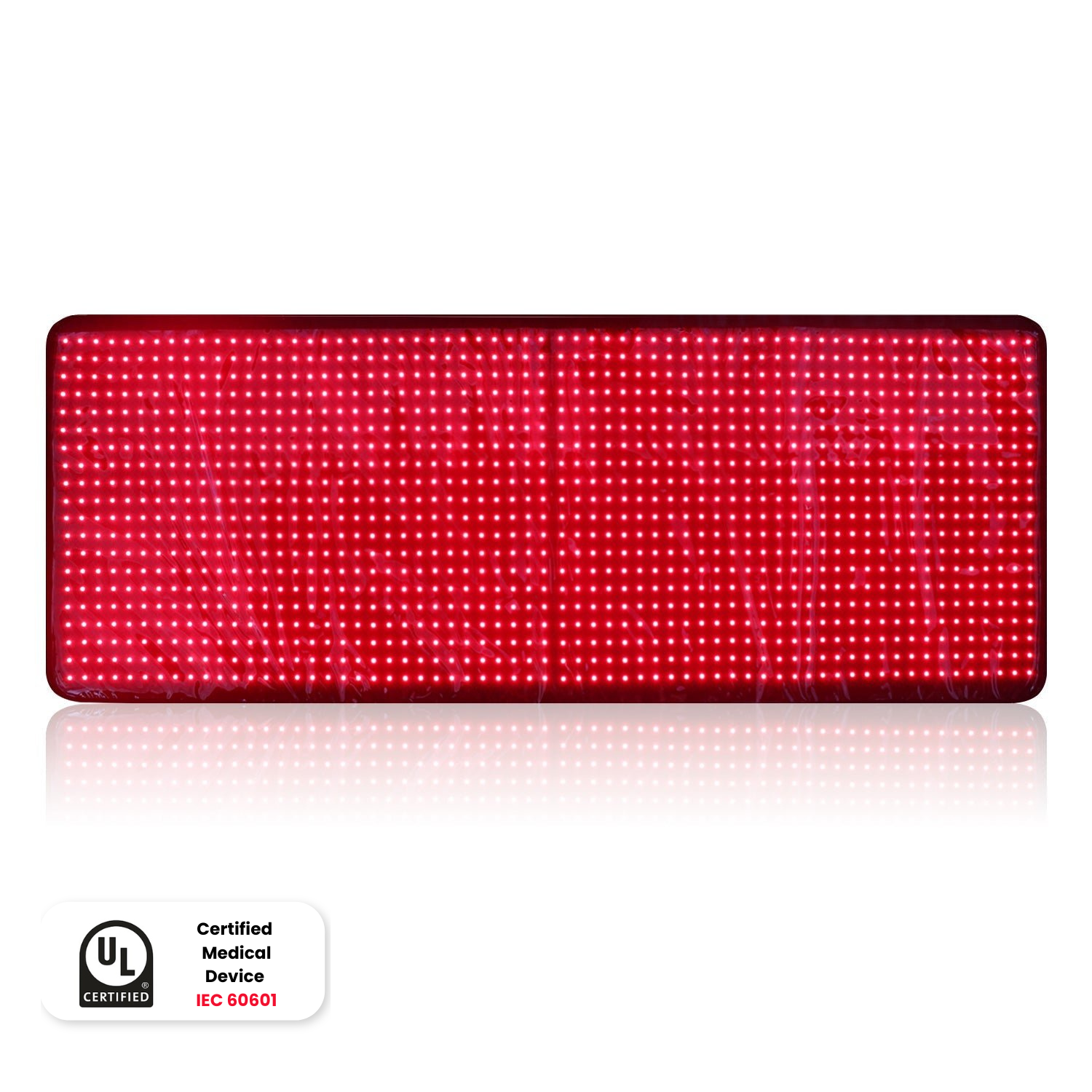DISCLAIMER: Mito Red Light devices are Class II wellness devices aimed at affecting the body through topical heating and supporting cellular function. The information provided in this article and on this site is for educational purposes only and is not intended to imply effectiveness of Mito Red Light devices for any specific application. The information provided in this article and on this site is not intended to diagnose, treat, cure, or prevent any disease, is not a substitute for consultation with a licensed medical provider and should not be construed as medical advice. Click here to read our article on potential contraindications of red light therapy..
In the quest for holistic health, many who care about their well-being often turn to nature for answers. One natural element that has garnered significant attention in recent years is light, specifically in the form of red and near-infrared (NIR) light therapy. This innovative approach to health and wellness leverages the power of specific wavelengths of light to promote healing and rejuvenation from within your own cells.
Anyone who has explored using red light therapy as part of their health journey will quickly find that red light therapy actually uses two types of light - red light and near-infrared light. It can initially be confusing why these two different wavelengths are used and what the difference is between them. Any wishing to learn more about the benefits of red light therapy, should understand the difference between red and near infrared.
Understanding these two types of light and why they are used together is important for anyone who is serious about using red light therapy. Whether you're an athlete looking for faster recovery, someone struggling with sleep issues, or simply seeking a natural way to enhance your overall well-being, understanding the nuances of this type of therapy is important.
The Science of Light Therapy
Light therapy is a type of medical therapy used in hospitals and doctor’s offices around the world. Light therapy is a general term that involves much more than just red light therapy and includes other wavelengths of light, like ultraviolet light. Light is absorbed by specific molecules in our cells, creating biological effects. This effect is most obvious in the biological process that underlies sight; however, there are many other effects light has on our bodies that can be leveraged to achieve therapeutic benefits.
Photobiomodulation is the scientific term for the effect that specific wavelengths of light can have on biological tissue. It's a process where light energy is absorbed by the cells, leading to various physiological changes. This absorption of light energy can stimulate cellular repair, reduce inflammation, and enhance energy production at the cellular level. Both red and NIR light therapies fall under the umbrella of photobiomodulation, but they work in slightly different ways and have different applications.
Red Light Therapy
Red light therapy utilizes both red and infrared light wavelengths of light, typically ranging between 630-930 nanometers. These wavelengths of light are typically combined and are lower in energy than the shorter wavelengths of ultraviolet light. This makes them safer than ultraviolet light, avoiding the serious damage to DNA that can be caused by high-energy light.
Another important trait of red and infrared light, when compared to other types of biomodulation, is the deeper penetration these wavelengths provide. Lower energy light with longer wavelengths can penetrate deep beneath your skin, unlike light like ultraviolet wavelengths that are absorbed almost completely by the upper layers of your skin. The deeper penetration used in red light therapy enables these wavelengths to reach tissues like muscles and tissue under your skin, providing effects that other wavelengths cannot.
The actual effects of red light therapy are thought to be caused when red and infrared wavelengths are absorbed by a molecule in your cells called cytochrome C oxidase. This chemical has been demonstrated to be affected by these wavelengths and plays an important role in the production of energy in the cell. Cytochrome C oxidase exists in mitochondria, the tiny cellular organs that turn glucose into energy your body can use. Most of the benefits of red light therapy are believed to be caused by stimulating increased energy production in the cells
Benefits of Red Light Therapy
The benefits of red light therapy are an ongoing area of research, with new applications continuing to emerge. There are, however, several uses that are quite popular as this form of therapy has become more available.
Sleep
One of the more recently discovered beneficial aspects of red light therapy is its ability to improve sleep quality. Exposure to red light has been shown to regulate melatonin production, the hormone responsible for sleep, potentially improving the quality and duration of sleep. This can be particularly beneficial for those who struggle with irregular sleep patterns.
Muscle Recovery
Athletes and fitness enthusiasts are increasingly turning to red light therapy for muscle recovery. Professional sports teams are starting to offer it to their athletes as a way to improve their edge. The therapy is used to help reduce inflammation caused by activity and decrease muscle soreness post-exercise, thereby speeding up the recovery process. It is also used to help protect the muscles from damage during workouts, helping to improve stamina. These effects can allow for more efficient training and better performance over time.
Healing
Red light therapy’s first use was to accelerate the healing process of the body by enhancing cellular regeneration and increasing blood flow to the affected areas. The increased energy stimulation red light therapy provides to cells is thought to improve how quickly cells replicate, accelerating the healing process. This makes it a potential tool for healing wounds, reducing scar tissue, and even aiding in the treatment of chronic conditions such as arthritis.
Hair Loss
Red light therapy has been found to stimulate hair follicles, promoting hair growth and increasing hair density. This non-invasive approach is becoming a popular alternative to traditional hair loss treatments. Red light therapy can be used for hair loss caused by medical conditions or by age-related changes.
Skin Health
Skin health applications are a rapidly growing area of red light therapy use. The benefits that red light therapy can offer in the area of skin health are numerous. It is thought to stimulate collagen production, potentially helping in reducing signs of aging, such as wrinkles and fine lines, and improves skin complexion. The increased healing speed red light therapy can provide can also cause blemishes and scars to heal more quickly, helping provide the skin with a more even and healthy appearance.
Red versus NIR Light Therapy – Understanding the Differences
Red and infrared wavelengths, when used in combination, offer a comprehensive approach to holistic health and wellness. Each type of light therapy has its unique strengths, and together, they provide a synergistic effect that can address a wide range of health concerns.
Red Light
Red wavelengths are typically in the 630-660 nanometer range and primarily target the skin and superficial tissues. These wavelengths are more likely to be effective for skin-related conditions due to their ability to stimulate collagen production, an essential protein for maintaining skin elasticity and strength. This aspect of red light therapy makes it a popular choice for anti-aging treatments, helping to reduce wrinkles, improve skin texture, and promote a youthful complexion. Additionally, red light's anti-inflammatory properties make it beneficial for skin-related applications, improving the structure and appearance of the skin.
Near-Infrared Light
The infrared wavelengths used in red light therapy are technically near-infrared (NIR) wavelengths. This subset of infrared light is close to the visible spectrum but is not quite red light. NIR light is about 800-930 nanometers and is known to provide deeper tissue penetration. This quality allows NIR light to effectively reach muscles, joints, and even bones, making it an invaluable tool for addressing deeper musculoskeletal issues.
For individuals experiencing chronic joint pain, deep muscle injuries, or those in recovery from intense physical activities, NIR light therapy can be particularly beneficial. It can help reduce inflammation and pain at a deeper level and enhance cellular energy production, thereby promoting faster healing and recovery of these deeper tissues.
Combined Effects
When combined, red and NIR light therapies offer a holistic treatment approach. The red light tends to work more on the surface, improving skin health and aiding in external healing, while NIR light penetrates deeper, addressing muscle and joint health and promoting internal healing. This combination ensures that both the external and internal aspects of health are addressed, making it a versatile and effective solution for a wide range of health and wellness goals.
Practical Considerations
Many red light therapy panels use both red and NIR light, with users forced to resort to the combination of the specific panel they have purchased. Some panels, however, provide the option to control the specific wavelengths you use, enabling you more control over the sessions.
There are some practical considerations when taking the differences between the two types of light into account. Here are some of the most important things to consider:
- Visualization of the light when on - Red light is visible to the naked eye, while NIR light is not. This means that when your panel is on, you will see the red light but not the NIR light. It can seem strange initially; however, the NIR light is on even if you can’t see it.
- Determining what works best - Red light therapy has worked well for many people, but there is still a lack of consensus on exactly how you should use it. This means that you may need to experiment with different light combinations to figure out what works best for you individually.
- Using combined wavelengths - Biological reactions with light can be improved with multiple, similar wavelengths. This means that using two similar NIR wavelengths and two similar red wavelengths may be more effective than using one single wavelength at a time. Combining wavelengths, even if they are similar, can be more effective than relying on a single wavelength.
Beyond the practical considerations for red versus NIR light, there are some more general considerations to keep in mind when incorporating red light therapy into your wellness routine. Firstly, consistency is key. Regular sessions are necessary to achieve and maintain the desired results. Secondly, the quality of the light therapy device plays a significant role in the effectiveness of the treatment. High-quality panels ensure proper wavelength emission and penetration, which is crucial for achieving therapeutic benefits.
Mito Red Light’s Approach
At Mito Red Light, we combine red and NIR light in our panels in different ways. We provide combinations tailored for specific purposes, but we also offer panels that let you choose how you would like to balance different light types. This provides you with greater control over your sessions, empowering you to plan your approach the way you want.
Not all red light therapy panels are created equal. For red light therapy to be worth the investment, you need a high-quality, independently tested, professional red light therapy device from a reputable company. With over 5 years in business and over 65,000 ecstatic customers, Mito Red Light is a brand you can trust. Our nearly 2,000 reviews speak for themselves. You can also click to review some of our customers' red light therapy before and after examples.
We are confident that our devices are the highest quality and best value at home red light therapy devices available anywhere. We welcome you to review our selection of red light therapy devices or to contact one of our representatives at 1-866-861-6486 to learn more or to help find the right solution for you.






























